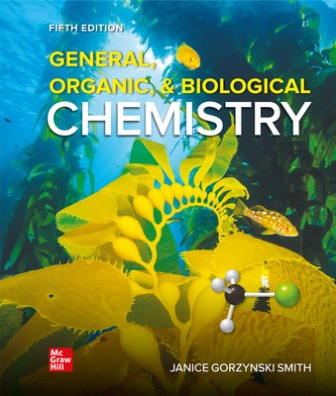Test Bank for General Organic and Biological Chemistry 5th Edition Smith
- Digital Download Instant Delivery
- Publisher : McGraw-Hill Education; 5th edition (April 23, 2021)
- Language : English
- ISBN-10 : 1264647417
- ISBN-13 : 978-1264647415
In Stock
Original price was: $75.00.$45.00Current price is: $45.00.
Test Bank for General Organic and Biological Chemistry 5th Edition Smith
Chapter 1: Matter and MeasurementChapter 2: Atoms and the Periodic TableChapter 3: Ionic CompoundsChapter 4: Covalent CompoundsChapter 5: Chemical ReactionsChapter 6: Energy Changes, Reaction Rates, and EquilibriumChapter 7: Gases, Liquids, and SolidsChapter 8: SolutionsChapter 9: Acids and BasesChapter 10: Nuclear ChemistryChapter 11: Introduction to Organic Molecules and Functional GroupsChapter 12: AlkanesChapter 13: Unsaturated HydrocarbonsChapter 14: Organic Compounds that Contain Oxygen, Halogen, or SulfurChapter 15: The Three-Dimensional Shape of MoleculesChapter 16: Aldehydes and KetonesChapter 17: Carboxylic Acids, Esters, and AmidesChapter 18: Amines and NeurotransmittersChapter 19: LipidsChapter 20: CarbohydratesChapter 21: Amino Acids, Proteins, and EnzymesChapter 22: Nucleic Acids and Protein SynthesisChapter 23: Metabolism and Energy ProductionChapter 24: Carbohydrate, Lipid, and Protein MetabolismChapter 25: Body Fluids
Introduction
“General, Organic, and Biological Chemistry, 5th Edition” by Janice Gorzynski Smith is a fundamental resource for students in chemistry and related fields. The accompanying test bank is an essential educational tool designed to reinforce learning, assess understanding, and prepare students for exams and practical applications in chemistry.
Overview of the Book
The 5th edition of “General, Organic, and Biological Chemistry” by Janice Gorzynski Smith provides a comprehensive introduction to key concepts in general, organic, and biological chemistry. The text is structured to support students’ understanding through clear explanations, real-world examples, and a variety of learning aids.
Key topics include:
- Basic concepts of chemistry and measurements
- Atomic structure and periodic trends
- Chemical bonding and molecular geometry
- Chemical reactions and stoichiometry
- States of matter and solutions
- Organic compounds and their reactions
- Biomolecules, including carbohydrates, lipids, proteins, and nucleic acids
- Metabolic pathways and bioenergetics
Importance of the Test Bank
The test bank for “General, Organic, and Biological Chemistry, 5th Edition” is a crucial resource for both instructors and students. It includes a variety of question types that assess students’ understanding and application of chemical concepts, ensuring thorough preparation for exams and real-world applications.
Benefits of the Test Bank:
- Enhanced Learning: Students can practice and reinforce their knowledge through diverse questions that cover all chapters of the book.
- Exam Preparation: The test bank helps students prepare effectively for various types of assessments, including quizzes, midterms, and final exams.
- Critical Thinking Development: Scenario-based questions encourage students to apply chemistry concepts in practical situations, fostering critical thinking skills.
- Instructor Support: Instructors can use the test bank to create customized quizzes and exams, ensuring comprehensive evaluation of student knowledge.
Key Features of the Test Bank
1. Diverse Question Types: The test bank includes multiple-choice, true/false, short answer, and essay questions, catering to different assessment needs and learning styles.
2. Scenario-Based Questions: Scenario-based questions present real-life chemical problems that require students to apply their knowledge and critical thinking skills to solve them.
3. Detailed Rationales: Each question is accompanied by a detailed rationale, explaining the correct answer and providing additional context. This feature aids in the learning process, helping students understand the reasoning behind each answer.
4. Comprehensive Coverage: The test bank covers all chapters and key topics from the textbook, ensuring a thorough assessment of the material. Students can use the test bank to review each chapter comprehensively, ensuring no topic is overlooked.
Sample Questions from the Test Bank
Multiple-Choice Question:
- Which of the following elements has the highest electronegativity?
- a) Sodium (Na)
- b) Chlorine (Cl)
- c) Carbon (C)
- d) Hydrogen (H)
Scenario-Based Question: 2. A patient requires a solution with a specific molarity of glucose for intravenous administration. Describe the steps you would take to prepare 1 liter of a 0.5 M glucose solution, including the calculations and equipment you would use.
Short Answer Question: 3. Explain the concept of hydrogen bonding and its significance in the properties of water.
Essay Question: 4. Discuss the role of enzymes in biological reactions. Include an explanation of how enzymes lower activation energy and the factors that affect enzyme activity.
True/False Question: 5. True or False: In an exothermic reaction, heat is absorbed from the surroundings.
Conclusion
The test bank for “General, Organic, and Biological Chemistry, 5th Edition” by Janice Gorzynski Smith is an invaluable resource that enhances the learning experience for chemistry students. By providing diverse, comprehensive, and scenario-based questions, the test bank prepares students for both academic success and practical competence in the field of chemistry. It supports instructors in delivering effective assessments and fosters a deeper understanding of the principles and applications of general, organic, and biological chemistry.


Reviews
There are no reviews yet.